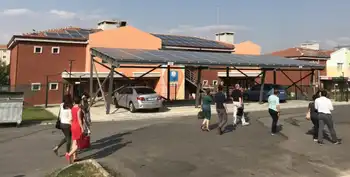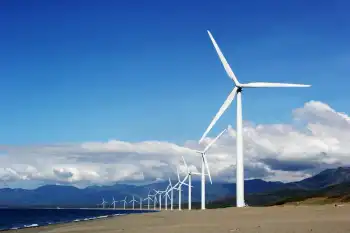How will renewable energy impact the environment?
In the United States, at least 67 million acres will be developed for new energy projects by 2030. While these projects — including wind, solar and biofuels — will help reduce carbon emissions and energy use, they will require a lot of land that is currently open or undeveloped — land that wildlife depend on.
So how can we develop new energy projects that don’t harm nature or wildlife? One key aspect is proper siting of projects, says Nature Conservancy scientist Rob McDonald. He co-authored a new study published in today’s PLoS One online journal that examines the impacts of “energy sprawl” — and says we need to start thinking about it now to ensure that new energy doesn’t harm nature and wildlife.
We sat down with Rob to find out more about the study and its findings:
Cool Green Science: First of all, can you explain exactly what “energy sprawl” is and why it matters now?
Rob McDonald: “Energy sprawl” is our term for the amount of space it takes to produce energy, and the general tendency for energy production to take more space over time. Energy development can, if improperly sited, impact natural habitats and the wildlife that depend upon them, so The Nature Conservancy is concerned about energy sprawl’s potential impact.
We initiated the current study because itÂ’s a moment of unprecedented change in the energy sector. As Congress considers ways to reign in U.S. greenhouse gas emissions, there will be a switch to more renewable energy technologies that will need more space. In this study we wanted to quantify the potential future scope of these energy sprawl impacts.
CGS: What did you find out — will new energy production in the United States have significant impacts on nature?
U.S. energy policy picks which technologies are winners and losers, and in the process picks which habitats will be impacted and which wonÂ’t.
For instance, if carbon capture and storage becomes available for coal-burning power plants — which would require significant government subsidy to spur its development and implementation — then coal mining has to continue to feed those power plants, with impacts on specific habitats.
On the other hand, since the United States can meet some of its energy needs through the use of coal, the availability of carbon capture and storage for coal means that there would be relatively less growth in the wind power industry, limiting the impact from that technology in windy parts of the country.
But there is a potential for a fairly large amount of energy sprawl, with or without action by the U.S. Congress on a cap-and-trade bill. It turns out that the majority of the land-use impacts for producing energy will come from growing biomass for liquid fuels like ethanol, as mandated by the renewable fuel standard and other laws. Those laws are already in place, so whatever Congress does with climate change policy will not affect their energy sprawl impact.
CGS: Were you able to identify what types of new energy projects will have the most impact on nature? The least?
ItÂ’s important to remember that energy sprawl concerns are only one of several ways to evaluate different energy production techniques, including climate change implications, cost efficiency, job creation, and issues of energy independence. Moreover, the environmental impact of much energy sprawl could be limited with proper siting, a philosophy The Nature Conservancy calls Energy By Design.
From the perspective of The Nature Conservancy, any new energy project that helps reduce U.S. emissions of greenhouse gases while avoiding impacts to sensitive species is a good project. We are not specifically advocating for any one energy production technology, just serious consideration of the potential environmental impacts of energy sprawl.
CGS: So how do we proceed with energy development on a mass scale — 67 million acres — in a way that also takes into account impacts to nature and wildlife?
There are three things that conservationists can advocate for to avoid impacts to nature, or minimize them:
• Maximize energy conservation and energy efficiency as much as possible. Saving energy saves land by avoiding energy development.
• Build incentives for the use of abandoned or degraded land. Particularly for biomass growth for liquid fuels or for electricity, natural habitat impacts could be minimized if the clearing of natural habitat was avoided.
• Where possible, site new energy development only where sensitive species will not be impacted.
CGS: But how can we make sure that policymakers are taking into account the potential impact of energy development on lands and wildlife?
The Nature Conservancy is talking with policymakers on Capitol Hill all the time to make sure that energy sprawl concerns are one of the issues that are on the table as energy policy is discussed. ItÂ’s been difficult, because we want to stress our strong support for climate change legislation while describing how the details of the legislation can be altered to minimize energy sprawl.
The same kinds of discussions are taking place in many states where the Conservancy works, as several state legislatures consider their own energy policy. Members of the Conservancy who feel passionate about this issue should contact their local office to find ways to get involved.
CGS: Finally, biofuels — good or bad?
IÂ’m not interested in labeling any technology as either good or bad. Biomass production for biofuels or for electricity will be one important part of a new energy system that avoids catastrophic climate change, and should be. Biomass production can create jobs, promote energy independence, and in some cases limit carbon dioxide emissions, and those benefits need to be compared to the potential negative impacts of energy sprawl.
Sadly, it is getting hard to have a rational, scientific debate about those pluses and minuses, because there is a lot of rhetoric out there from both sides that makes simplistic arguments about the worth of biofuels and attacks all data that isnÂ’t consistent with their preconceived conclusions.
So, I think the good versus bad debate is a bit of a distraction, and has sadly led to people not discussing siting issues or energy efficiency issues as much as they should.
Related News

IEA: Electricity investment surpasses oil and gas for the first time
LONDON - Investments in electricity surpassed those in oil and gas for the first time ever in 2016 on a spending splurge on renewable energy and power grids as the fall in crude prices led to deep cuts, the International Energy Agency (IEA) said.
Total energy investment fell for the second straight year by 12 per cent to US$1.7 trillion compared with 2015, the IEA said. Oil and gas investments plunged 26 per cent to US$650 billion, down by over a quarter in 2016, and electricity generation slipped 5 per cent.
"This decline (in energy investment) is attributed to two…





